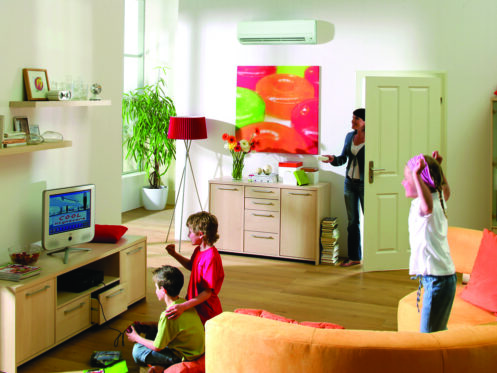Standard HVAC systems use a single zone, which means when the system runs, it’s heating or cooling your entire home. The problem is that every room may not need heating or cooling during every cycle, so providing it anyway reduces efficiency, increases energy costs, and adds wear. HVAC zoning separates your home into multiple areas called zones, so only the areas needing conditioned air receive it. We’ll explore the types of zoning systems, their benefits and costs, and how to determine if they are right for your home.
Types: Ductless and Ducted
Zoned HVAC equipment comes in ductless and ducted systems. Ductless systems, called mini-split systems, use small air handlers throughout your home rather than one larger central air handler. Ductless systems work with heat pumps and geothermal systems. For most homes, all refrigerant lines run to a single outside unit.
On the other hand, ducted systems use dampers installed in the ducts. The dampers open and close based on whether the zone needs the conditioned air at that moment. Each zone is controlled by either an independent thermostat or a simple sensor that connects to a central thermostat.
Benefits
Homes best suited for multiple zones can expect several benefits. The sooner you install zones, the greater the benefit you’ll see over the life of your system.
Better Comfort Control
One of the primary benefits of zoned systems is better comfort control around your home. They help balance those areas that tend to stay too hot or cold. Additionally, if you opt for independent thermostats, you can have different temperature settings for each zone.
Reduced Heating and Cooling Costs
Another substantial benefit is that zoned systems tend to help reduce heating and cooling costs. Ducted systems direct air to those areas that need it, shortening the cycle or reducing the capacity it’s running for high-efficiency systems. Ductless air handlers tend to use less power than a central air handler, reducing the energy consumed by running only the handlers you need. Additionally, because the temperature is better controlled, many homeowners find ductless HVAC less burdensome than a central system.
Less Wear
One of the headaches every property owner faces is the eventual need for repairs and a system replacement. Zoned systems help reduce these costs by reducing the wear the system experiences while running. First, you’ll have fewer repairs over the life of your system. Additionally, less wear means your system will last longer, reducing the annualized costs of a replacement.
Accommodating Family Preferences
If you have family members who feel too hot or cold, you can use zoning to make a more comfortable space for them. This is especially useful if they spend alone time in a craft room, home office, man cave, gaming room or other space.
Installation Costs
Several factors affect the installation cost of a zoned HVAC system. First, you must decide whether you are zoning a ducted system or installing a ductless mini-split. Most homes with a central system will opt for zoning through the ducts rather than installing a new ductless system.
A significant consideration for ducted systems is whether to install them in an existing system or as part of new construction. For existing systems, costs will vary based on how much work is required to access the ducts through walls or under floors.
The number of zones you install will also affect the cost of both ductless and ducted systems. Each air handler in a ductless system can range from $500 to over $2,000 and typically has the thermostat built in. Ducted systems will need each zone’s damper, actuator, and sensor or thermostat.
Installing zones into an existing central HVAC system can cost $2,000 to over $12,000, and installing a ductless mini-split system can cost $4,000 to over $20,000. If you work with your HVAC professional and utility companies, they may be able to show you some tax rebates that you qualify for by making your home more energy efficient.
Types of Homes That Benefit From Zoning
While every home may benefit from zoning, some houses will experience more significant improvements. Those structures may have:
- Multiple floors
- A basement
- Living space in the attic
- Vaulted ceilings
- An over-garage apartment or office
- A sunroom
- Several large windows
- A multiple-winged floor plan
Offering expert heating and cooling installation, maintenance, and repair, Xtreme Heating & Cooling LLC has served property owners in and around Omaha, NE since 2012. Our team also provides ductless mini-split systems and indoor air quality solutions for your home’s unique needs.
Call Xtreme Heating & Cooling LLC to schedule a consultation with one of our certified technicians to explore whether HVAC zoning is right for your home.
